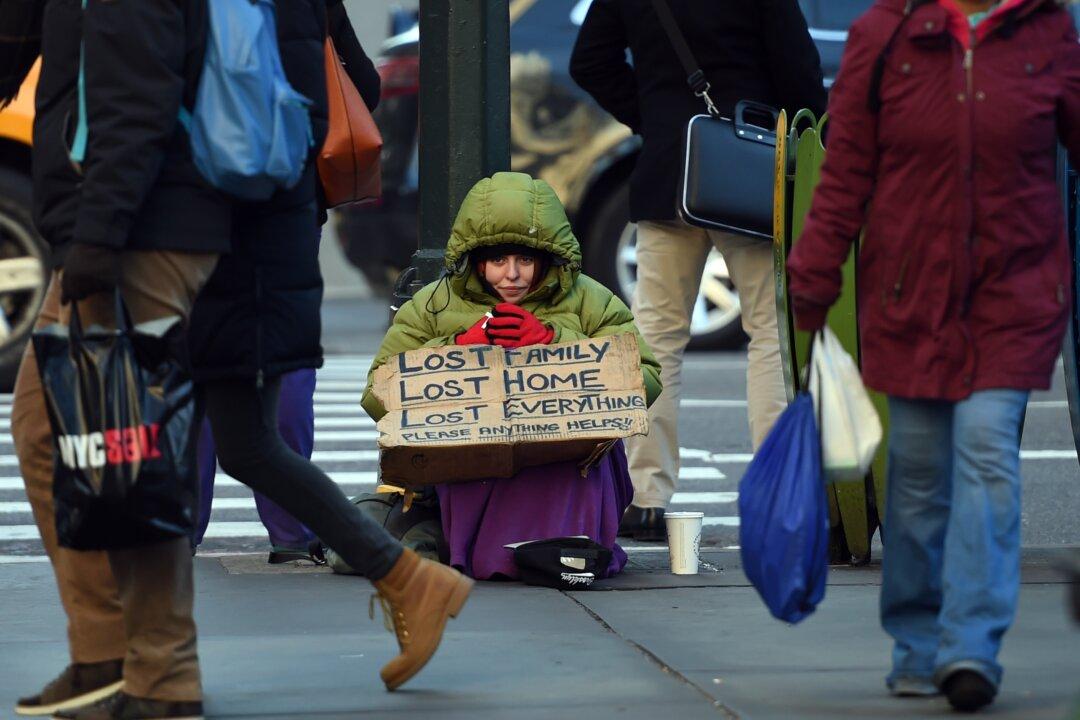NEW YORK—As New York City pours hundreds of millions more into its homeless services, the homeless population continues to climb, testing Mayor Bill de Blasio’s campaign promise to tackle the problem.
On Sept. 29, almost 60,000 people spent the night at the city’s homeless facilities—setting a record likely to be broken on next count, too. The number of homeless has been increasing for the past decade.
Meanwhile, the city’s Department of Homeless Services repeatedly blows through its budget limit, spending over $1.3 billion during the last fiscal year—more than 23 percent over budget.
De Blasio defended his lineup of new initiatives, saying the situation would have been worse without them.
While his preventative and transition programs do seem to diminish the growth of homelessness, they’re not reversing the trend.
History
In New York City, every man won the right to shelter after the 1979 New York Supreme Court ruling Callahan vs. Carey. The city entered into a consent decree with the plaintiffs guaranteeing temporary shelter to every man made homeless “by reason of physical, mental, or social dysfunction.”
The named plaintiff, Robert Callahan, died on the streets before the consent decree was signed.
The original ruling applied to men only. It was extended to women through another Supreme Court ruling in 1983 and to families in a 1987 ruling.
Since then, fewer people have frozen to death on the streets, but the city is saddled with running a costly shelter system.
Currently, the city spends $41,000 to shelter a family for a year. By comparison, the median household income was just shy of $53,000 in 2014.
Becoming Homeless
Two-thirds of people entering a shelter had lost their job during the prior five years. About half had been evicted. Other reasons for homelessness include domestic violence, overcrowded or hazardous living conditions, and family feuds, according to a 2005 Vera Institute of Justice study.
Two-thirds of people ending up in shelters are single parents (mostly mothers) with children. That’s partly why city shelters house almost 24,000 children.
From a long-term perspective, rents in the city rise faster than salaries, pushing poor people closer to eviction. Half a million (15 percent of) families in the city fell behind on their rent or mortgage payments last year.
Affordable Housing
The mayor promised to build 80,000 and preserve 120,000 affordable housing units by 2024. “Preserving” means the city uses subsidies to persuade landlords to continue offering their apartments as affordable housing.
So far, almost 53,000 extra units have been built or preserved some two-and-a-half years into de Blasio’s term.
But only 3,500 of them have been financed for those earning less than $24,000—such as a single mother living in a shelter who lands a minimum wage job.
The majority, 54 percent, of the new and preserved units are aimed at middle-income people, with rents in the $1,000 to $1,500 range.
Such middle-income apartments were easier to build through the 80/20 system, which was scrapped by the state in January after New York City refused to demand union-level wages for workers on the developments receiving the tax breaks.
Under the 80/20 rule, the city had allowed developers to build taller apartment buildings (many luxurious) in lucrative areas like Manhattan, Williamsburg, or Long Island City and gave them tax breaks in exchange for renting out 20-30 percent of the apartments under market price.
Population of Homeless Shelters and Budget in New York City






